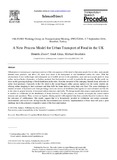- CERES Home
- →
- School of Management (SoM)
- →
- Staff publications (SoM)
- →
- View Item
JavaScript is disabled for your browser. Some features of this site may not work without it.
| dc.contributor.author | Zisis, Dimitrios | |
| dc.contributor.author | Aktas, Emel | |
| dc.contributor.author | Bourlakis, Michael | |
| dc.date.accessioned | 2017-03-16T09:47:27Z | |
| dc.date.available | 2017-03-16T09:47:27Z | |
| dc.date.issued | 2016-12-31 | |
| dc.identifier.citation | Zissis D, Aktas E, Bourlakis M, A new process model for urban transport of food in the UK, Transportation Research Procedia, Volume 22, 2017, pp588-597 | en_UK |
| dc.identifier.issn | 2352-1465 | |
| dc.identifier.uri | http://dspace.lib.cranfield.ac.uk/handle/1826/11606 | |
| dc.identifier.uri | http://www.u-turn-project.eu/uploads/5/7/8/1/57812149/procedia_ewgt16_zissis-aktas-bourlakis.pdf | |
| dc.description.abstract | Urbanisation is increasing at a rapid pace and one of the consequences of this trend is that more people live in cities, more people demand more products, and above all, more food needs to be transported to and distributed within the cities. With the advancement of new technologies and widespread use of mobile devices in the population, more and more people prefer to shop online, not just books, electronics, or fashion products, but food products as well, in particular the groceries. In this work, we focus on this growing challenge of food distribution in the cities, from the viewpoint of this emerging channel: home deliveries of online food purchases. Especially in the UK which is the second biggest online grocery market over the world, retailers are offering online shopping to their customers and then fulfil the home delivery using their own fleet. This poses challenges to retailers in terms of increased costs from providing a non-core service of distribution and logistics to end-consumers and the life in the cities in general in terms of increased carbon emissions and traffic. We design models that propose appropriate incentive to retailers to collaborate for the distribution of home deliveries. For this purpose, we initially investigate the current market structure and operations. Then, we test our logistics sharing models with empirical data from a retailer based in London to show the relevance of collaboration. Our results suggest that it is theoretically possible to collaborate and reduce economic, environmental, and social costs arising from the uncoordinated case; however, implementation of these ideas still pose a great challenge due to the extremely competitive nature of the food retail market. Paper presented at the 19th EURO Working Group on Transportation Meeting, EWGT2016, 5-7 September 2016,Istanbul, Turkey | en_UK |
| dc.language.iso | en | en_UK |
| dc.publisher | Elsevier | en_UK |
| dc.rights | Attribution-Non-Commercial-No Derivatives 3.0 Unported (CC BY-NC-ND 3.0). You are free to: Share — copy and redistribute the material in any medium or format. The licensor cannot revoke these freedoms as long as you follow the license terms. Under the following terms: Attribution — You must give appropriate credit, provide a link to the license, and indicate if changes were made. You may do so in any reasonable manner, but not in any way that suggests the licensor endorses you or your use. Information: Non-Commercial — You may not use the material for commercial purposes. No Derivatives — If you remix, transform, or build upon the material, you may not distribute the modified material. No additional restrictions — You may not apply legal terms or technological measures that legally restrict others from doing anything the license permits. | |
| dc.subject | Home Deliveries | en_UK |
| dc.subject | Co-opetition Model | en_UK |
| dc.subject | Reduction Cost | en_UK |
| dc.subject | Shared Logistics | en_UK |
| dc.title | A new process model for urban transport of food in the UK | en_UK |
| dc.type | Article | en_UK |
Files in this item
This item appears in the following Collection(s)
-
Staff publications (SoM) [1260]
